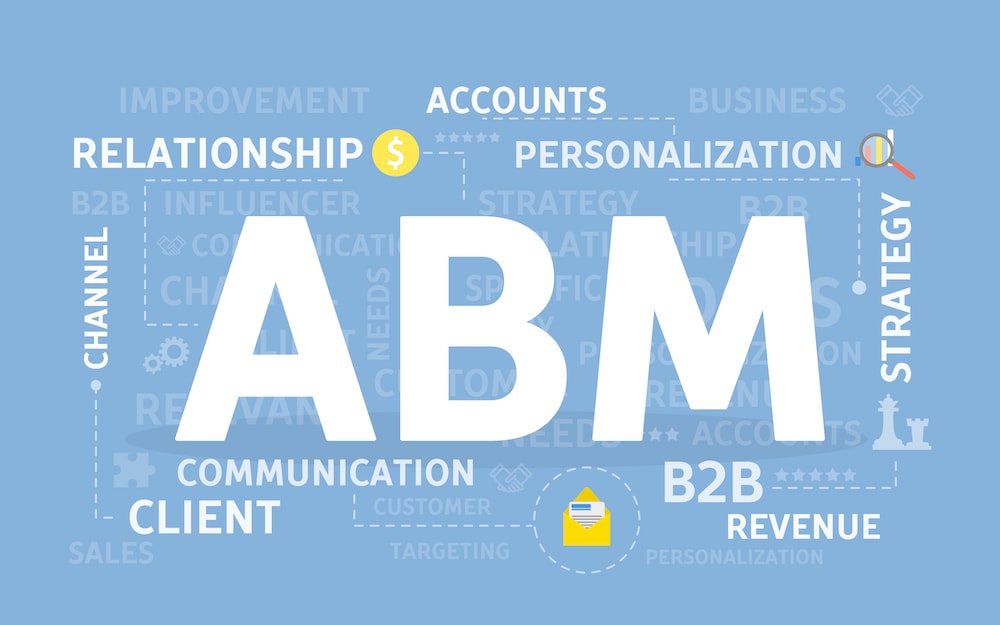6 Ways to Ace your B2B Strategy with Account-Based Marketing

Today, you can choose from multiple marketing avenues when you want to market and sell your products or services. You may target a range of customers, but some unqualified leads are always in the pipeline. Imagine if you could only sell and market your business to high-value customers. Wouldn’t that be great? Well, that’s precisely what Account-Based Marketing helps you achieve. The core idea is to align marketing and sales efforts to target specific accounts, most likely to convert and become long-term customers.
This means no time and money wasted on converting not-fit leads and closing more high-value accounts.
According to research, 87% of businesses using B2B Account-Based Marketing say it delivers a higher ROI than other marketing campaigns.
In this article, you’ll discover what ABM means and how to use it in your B2B strategy to grow your business revenue. You will understand how ABM can help you and how you can start using it from the get-go.
Let’s get started!
What is Account-Based Marketing (ABM)?
Account-based marketing is a growth strategy that targets identified high-value accounts through a personalized combination of sales and marketing.
In ABM, each account is treated as a separate market. The process includes personalizing your goals, buyer’s journey, buyer persona, communications, and campaigns tailored to those accounts.

Through ABM, you can filter out the high-value accounts and focus your efforts on converting them much faster. It saves time spent on converting unqualified leads and targeting your efforts on businesses with low potential.
So we can say that ABM uses targeted marketing, removing broad market targeting from the focus, which is challenging to scale.
For example, if you have a consulting service for businesses, instead of focusing on startups and SMBs, go after the accounts with a higher need for your services and the budget to pay for them.
With ABM, you can achieve a higher ROI since you’re focusing your efforts on selected high-value accounts. You will also experience customer loyalty through the ABM process because, with B2B, most businesses like to have a long-term collaboration with one service provider only.
6 ways to use ABM to enhance your B2B strategy
By now, you know what ABM is and why it benefits your business. But, learning how to incorporate it into your B2B strategy to grow your business is another thing.
You can use ABM tactics to build a foundation for your B2B strategy. This essentially means that there are many ways in which you can use account-based marketing to enhance your processes.
208% is how much revenue can increase with an ABM strategy.
Let’s dig deeper to see six ways in which you can use ABM for your strategy:
1. Incorporate ABM in your organizational workflow
If you want to integrate ABM into your strategy, you need to secure your organizational workflow. Account-based marketing is not a tactic, so the entire company must gain awareness, sign off, and work under it.
It requires all your company’s decision-makers and senior-level employees to contribute and be involved in the strategy processes. Since ABM is applied at every stage of the process, from lead qualification to conversion and retention, you must ensure everyone is on board with the idea.
Following this, creating an ABM action plan that maps out the process would be best. Consider focusing on these aspects:
- The goals and objectives for the strategy are broken into milestones
- Clear roles and responsibilities at every stage for the employees
- The measure of involvement required from internal stakeholders
- Marketing and sales team alignment
- ABM budget and resource allocation
- Metrics and KPIs for Result Analysis
Carving out the framework before you jump onto the process will create a benchmark and return point if anyone feels stuck with the structure. You can convert this into an ABM strategy document for everyone to refer to during the process.
It will maintain transparency, ensuring everyone knows where you’re headed.
2. Pay attention to accurate targeting
You’re investing time and effort in acquiring new businesses. If you want to target high-value accounts, then you need to ensure accurate targeting. You cannot shoot arrows in the air, hoping to hit the bull’s eye.
Your targeting needs to be backed by research and analysis. Without this, you could go after the wrong accounts, which are unqualified, take more time to convert, and not have the budget to avail yourself of your services.
Now, you must think of how to look out for high-value accounts for your targeting. While there are multiple ways to go forward, researching your target market and putting out relevant content will help you filter them.
Apart from this, try using these methods:
- Create eligibility criteria for your target accounts. This can be account size, industry, buying capacities, buying history, etc. Try looking out for businesses that meet these criteria only.
- Analyze your previous accounts to find out the characteristics of your ideal customer. Use those filters to look for such accounts on LinkedIn or within your network.
- Through metrics, you can analyze the leads flowing in and see which ones are qualified but not yet converted. Then, you can target the ones that meet your criteria.
- Search and connect with your ideal customer profile on LinkedIn. These can be stakeholders or buying committee members of your target account.
If you want your ABM efforts to yield results aligned with your B2B strategy, accurate targeting is non-negotiable. It’s the guiding factor for your sales and marketing process. So, it stands on the number one priority.
3. Use optimized content across platforms
Content is at the center of your B2B strategy. If you want to attract high-quality account clients, you’ll use tailor-made messaging conveyed through content.
For this, having optimized content that relays the message is crucial. Content is essential to building trust at every stage of the sales pipeline. Once you build trust with them, more content is used to engage and delight them into buying your product or service.

Since you’re targeting high-value accounts with ABM, you will need personalized content for them. Not only this, but you’ll also find out the marketing channels that best fit them and create content based on those channels.
Yes, we know what you’re thinking. That’s a lot of effort.
But is it worth it? Absolutely.
Consider this.
You analyze their pain points when creating content targeted at a broader market. However, all the prospects under that target market don’t need to have the same pain point.
The US ABM market is projected to reach $202.3 million.
When you use ABM, you know everything about the account you’re targeting. You use specifics like demographics, age, buying capacity, social media channels, and campaign potential to determine the best-fit content. This makes your messaging much more precise, increasing the chances of converting them.
Thus, content optimized for cross-platform marketing is essential.
You create content suitable for your target account and tweak it according to the platforms for sharing the content.
4. Align your sales and marketing teams
Account-based marketing is a team effort. Since it combines sales and marketing efforts to target and convert high-value accounts, synergy within the teams is essential.
For this to work, the teams must coordinate to produce the best output. The discrepancy can cost accurate targeting and, thus, the conversion of a high-value account.

For ABM to work, sales and marketing teams should combine their efforts and perform account planning together. Both aspects are essential to taking a prospect through the sales pipeline, retaining them, and ultimately converting them into a loyal client.
Now, the most critical question.
How should both these teams work together? Wouldn’t it make everything chaotic?
The answer is, it won’t if you organize the process the right way.
Consider answering these questions when sales and marketing efforts are combined:
- What kind of content would be needed at every stage?
- Which marketing channels will be used to share content?
- Who will be the target contact in the accounts?
- What kind of support will each team provide?
- How will the sales process run in alignment with marketing efforts?
These five questions will help set boundaries for both teams and ensure a seamless workflow. Defining clear expectations and responsibilities is essential for smooth working if these teams work together.
The ABM process can successfully yield results through the ongoing and effective collaboration of the sales and marketing teams.
The ultimate goal is to expand the business by closing large accounts. However, to achieve it, the sales and marketing teams should break down bigger goals into smaller ones. This will ensure the work is of high quality and meets the milestones within the timeline.
5. Make efforts to attract high-quality contacts
Your network is your net worth. So, try to look for high-quality contacts that belong to your target accounts in your network. If you’re relatively new to the industry, you might not have many connections; however, if you’ve been here for a while, use it to filter contacts belonging to high-value accounts.
While you can reach out to these accounts with a business proposition, having a personal connection makes it much easier to seal the deal or bring them into your sales pipeline.
If you’re not acquainted with contacts from these accounts, you can consider taking the following steps to get connected with them:
- Invite a thought leader from the target account for an interview or podcast.
- Engage with them on social media and start a conversation without pitching.
- Run targeted campaigns tailor-made for them.
- Create lead magnets like eBooks and checklists, which attract your target accounts and solve a pain point.
- Ask for referrals within your network or attend networking events where they will most likely be present.
The primary purpose of these efforts is to position yourself in front of your target accounts. This will boost your visibility and promote brand awareness, helping you pitch your services or get them as an inbound lead.
6. Use social intelligence to understand customer’s needs
Personalization is a core concept of ABM. You personalize your communication for an account based on the challenges they face. This means that understanding your prospect’s needs and their problems can help you create better messaging and content.
If you want to convert them, you need to hit the right spot. Social intelligence can determine their current situation and help you use it for accurate targeting.
82% of B2B marketers said ABM greatly improves sales and marketing alignment.
Social Intelligence is a way of listening to your target market’s decision-makers and influencers. It helps you understand their positioning, stay informed about updates, and build relationships.
Here’s how you can analyze their needs:
- Turn on Google Alerts for your target account to keep track of what is happening in the organization.
- Monitor their social media activity to catch up on updates.
- Analyze gaps by measuring their online presence and what they lack to assess how your product or service can fill these gaps.
- Study their relationship with their customers to understand what problems they solve and the messaging they relay.
- Follow the decision-makers of your target accounts on LinkedIn and Twitter. Engage with their content and start a conversation to get a first-hand insight into their challenges.
You can use Social Intelligence to engage with your target accounts and understand their challenges. This will help you incorporate personalization accurately, increasing the chances of response and conversion.
Conclusion
Account-based marketing is often seen as something advanced or overwhelming to carry out, but it’s one of the most effective marketing strategies to adopt. With B2B, you want to appeal to other businesses that involve several decision-makers. Going past all of that and ensuring your efforts yield results is what ABM will help you achieve.
There’s nothing more disheartening than spending time on lead generation and trying to convert unqualified leads. ABM ensures you’re targeting accounts that can turn into long-term loyal customers. This ensures recurring work and increased revenue.
Once you’ve identified valuable accounts to work with, personalization backed by your sales and marketing efforts will help you convert your target customers. Thus helping you grow your business exponentially.
Sources
- Webfx: Account Based Marketing Statistics
- Unbound B2B: Account Based Marketing
- lxahub: Account-Based Marketing



